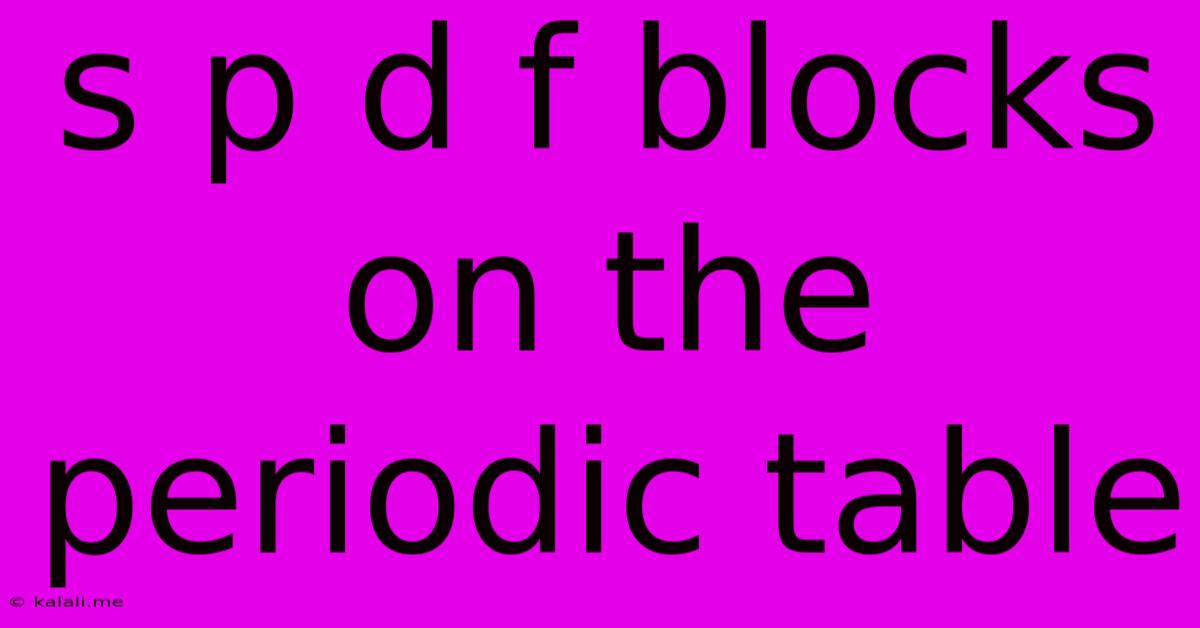S P D F Blocks On The Periodic Table
Kalali
Jun 12, 2025 · 3 min read

Table of Contents
Understanding the s, p, d, and f Blocks on the Periodic Table
The periodic table is more than just a list of elements; it's a visual representation of the organization of matter based on the electronic structure of atoms. This organization is reflected in the distinct blocks: s, p, d, and f. Understanding these blocks is crucial for comprehending chemical properties and reactivity. This article will delve into the specifics of each block, explaining their electron configurations and the trends observed within them.
What are s, p, d, and f blocks? These blocks represent the different subshells within the electron shells of an atom. Each subshell holds a specific number of electrons, influencing the element's properties. The blocks are named according to the orbital type (s, p, d, or f) where the outermost electrons reside. These outermost electrons, also known as valence electrons, are the primary drivers of chemical bonding and reactivity.
The s-Block Elements: Alkali and Alkaline Earth Metals
The s-block occupies the first two groups (columns) of the periodic table. It includes the alkali metals (Group 1) and the alkaline earth metals (Group 2). These elements are characterized by their relatively low ionization energies, making them highly reactive.
- Characteristics: Low electronegativity, readily lose electrons to form +1 (alkali metals) or +2 (alkaline earth metals) ions, exhibit metallic properties like conductivity and malleability.
- Examples: Sodium (Na), Potassium (K) (alkali metals); Magnesium (Mg), Calcium (Ca) (alkaline earth metals).
- Trends: Reactivity generally increases down the group, due to decreasing ionization energy. Atomic radius also increases down the group.
The p-Block Elements: Diverse Properties and Reactivity
The p-block encompasses Groups 13-18, occupying a large portion of the periodic table. This block includes a diverse range of elements, exhibiting a wide variety of properties. It contains both metals, non-metals, and metalloids.
- Characteristics: Varying electronegativity and ionization energies, leading to diverse chemical behaviors. Form covalent bonds readily.
- Examples: Carbon (C), Nitrogen (N), Oxygen (O) (non-metals); Aluminum (Al), Silicon (Si) (metalloids); Chlorine (Cl), Argon (Ar) (non-metals).
- Trends: Electronegativity generally increases across a period (from left to right) and decreases down a group. Atomic radius generally decreases across a period and increases down a group.
The d-Block Elements: Transition Metals
The d-block, located in the middle of the periodic table (Groups 3-12), consists of the transition metals. These elements are characterized by their variable oxidation states and the formation of colorful compounds.
- Characteristics: High melting and boiling points, good electrical and thermal conductivity, often form complex ions, exhibit catalytic activity.
- Examples: Iron (Fe), Copper (Cu), Zinc (Zn), Titanium (Ti).
- Trends: Trends in properties are less pronounced than in the s and p blocks due to the complex interplay of electronic configurations.
The f-Block Elements: Lanthanides and Actinides
The f-block elements, also known as the inner transition metals, are placed separately at the bottom of the periodic table. They are divided into the lanthanides and actinides.
- Characteristics: Similar chemical properties within each series, primarily +3 oxidation states, radioactivity is common amongst the actinides.
- Examples: Cerium (Ce), Praseodymium (Pr) (lanthanides); Uranium (U), Plutonium (Pu) (actinides).
- Trends: Properties are very similar within each series due to the filling of the inner 4f (lanthanides) or 5f (actinides) orbitals.
In summary, the s, p, d, and f blocks provide a fundamental framework for understanding the organization and properties of elements on the periodic table. Each block exhibits distinct characteristics influenced by the electronic structure of its constituent elements, driving their unique chemical behaviors and applications. Further exploration of these blocks reveals the intricate relationships between electron configuration, atomic properties, and the diverse world of chemical reactions.
Latest Posts
Latest Posts
-
Which Of The Following Are Examples Of Operating Systems
Jun 13, 2025
-
What Is The Square Root Of 4000
Jun 13, 2025
-
Which Of The Following Is A Type Of Implicit Memory
Jun 13, 2025
-
Distance Of A Penalty Kick Soccer
Jun 13, 2025
-
Earth Is Divided Into How Many Time Zones
Jun 13, 2025
Related Post
Thank you for visiting our website which covers about S P D F Blocks On The Periodic Table . We hope the information provided has been useful to you. Feel free to contact us if you have any questions or need further assistance. See you next time and don't miss to bookmark.